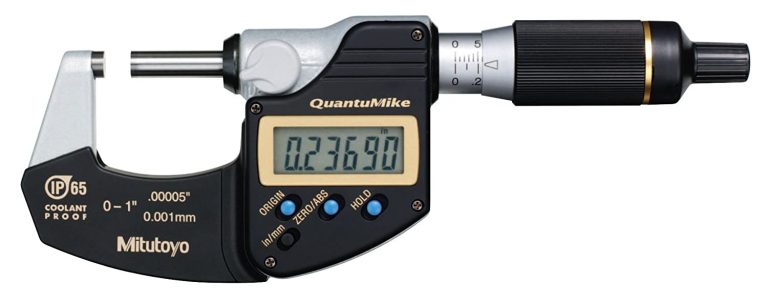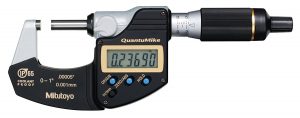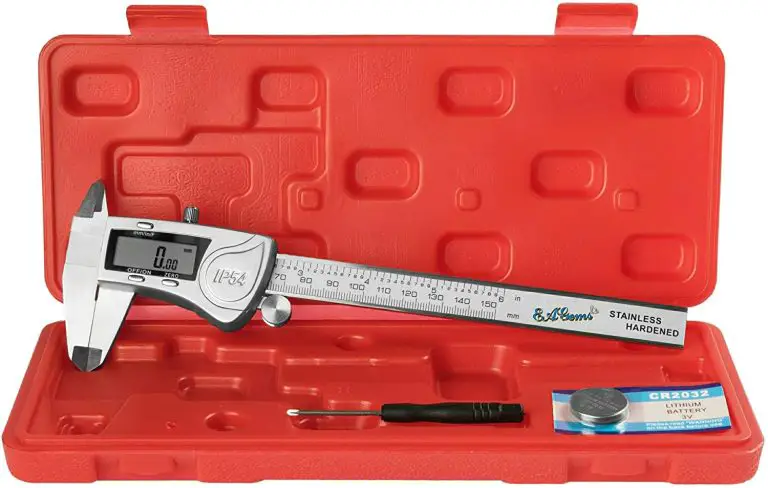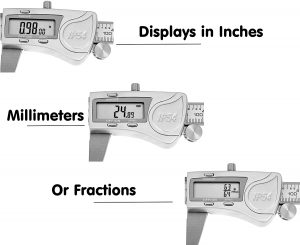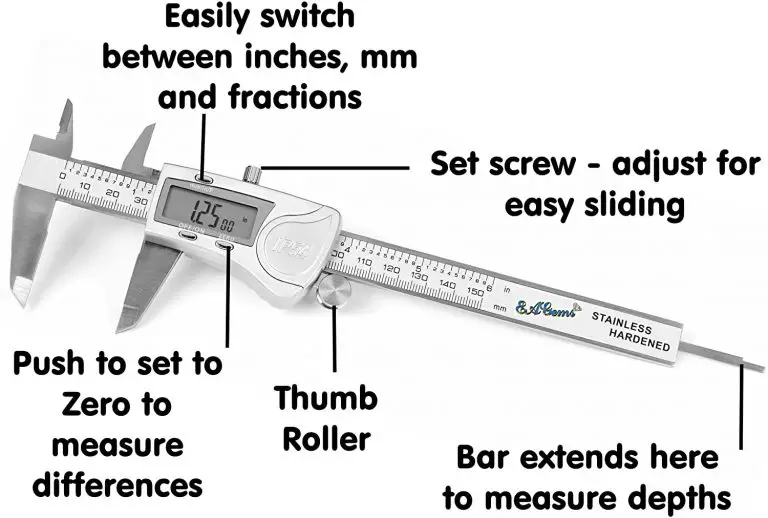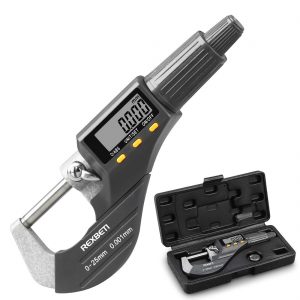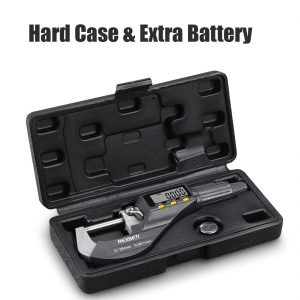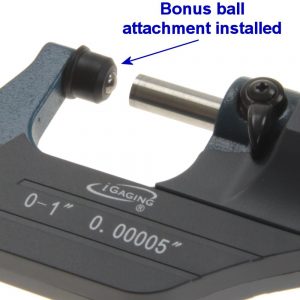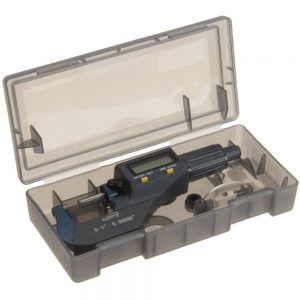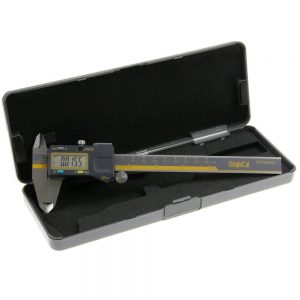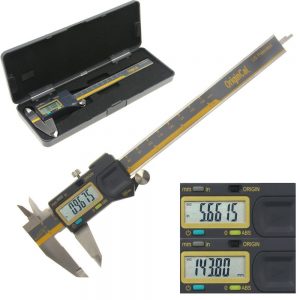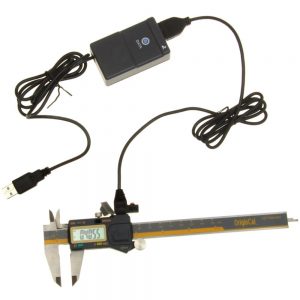Summary
Straight to the point. The Mitutoyo QuantuMike digital micrometer is an excellent inspection tool. It does everything an ordinary micrometer does but four times faster. Simply put, this is a top of the line measuring tool but the quality comes at a price.
Let’s get into the features.
Features
The QuantuMike has a big easy to read LCD display. It reads measurements in both inches and millimeters. Inch and metric values are switched at the press of a button.
Speaking of buttons…
The buttons on this micrometer and frankly all of the Mitutoyo Digimatic micrometers I have used, pull off something that seems very simple but in practice isn’t. The buttons are both easy to use and hard to press on accident. What this means is that your measurements are never lost because you accidentally hit the origin button. It can be hard to describe how the feel of a tool plays into its quality. In this case the QuantuMike just feels good.
Build quality
The build of the QuantuMike digital micrometer is excellent. None of the plastic and metal components of the mic seem cheap or flimsy. It’s solid. One potential negative is that some may find the weight of tool a little on the heavy side. I have never found this to be the case but all of Mitutoyo’s Digimatic micrometers are balanced differently than a normal, non-digital micrometer which might feel strange to some. It may take a little getting used to but once it clicks, you won’t want to go back to a standard mic.
Battery
Battery life for the QuantuMike is listed at 2.4 years. That seems a little long to me, but in practice the standard SR44 battery lasts long enough that I don’t think about it and just try to keep an extra battery on hand. This has been my experience with what I would call a medium amount of use in your standard machine shop. If you are going to use it in your garage sporadically, then I would venture to guess the battery will die of old age before being drained.
Protection from the elements
The QuantuMike has an IP rating of IP65. IP stands for ingress protection and the two numbers tell you how well protected from solids and liquids the instrument is. Protection from dust and coolant is what you should look for in an IP rating.
The first digit, 6 in this case, is for solids protection and the QuantuMike is completely protected from dust. This is the highest level of solids protection on the IP rating scale.
The second digit, 5 for the QuantuMike, is for liquids protection. The QuantuMike is protected from water jets from any direction.
The video below shows what level of protection this provides. I would not recommend recreating the test at home with something as nice as this digital mic. Practically, it means your tool will be safe from splashing coolant. However, you should still do your best to keep it clean and dry.
Speaking of clean and dry, the provided plastic case will help you keep it that way. The QuantuMike comes with a fairly standard plastic case but it gets the job done. I should also note that while not all micrometers come with a case, I would certainly expect one for a tool in this price range.
Accuracy

Let’s face it, accuracy is by far one of the most important qualities of a micrometer. It’s a measuring tool so it isn’t worth much if it won’t measure with accuracy and precision. Luckily the QuantuMike is extremely accurate. Boasting .00005”/.001mm accuracy, this micrometer is highly accurate and precise. Measurements repeat very well.
Speed
The standout speed of the QuantuMike is what sets it apart from other digital micrometers. Each revolution of the thimble moves the anvil in or out .080” or 2mm.
That is four times faster than a standard micrometer. Not the type of feature that matters to a hobbyist even though it is convenient, but for someone checking hundreds or possibly thousands of parts per day it can mean a huge amount of time saved.
Most machinists will use a 6” caliper or a 0-1” micrometer more than any other measurement device. It’s a good idea to have a quality set for these highly used tools.
Other features
- Carbide tips
- Thimble ratchet for consistent measurements
- Measurement lock
- Some versions have SPC output
- 1 year warranty, 3 if registered with Mitutoyo
Verdict
The Mitutoyo QuantuMike digital micrometer is an excellent piece of measuring equipment. The precision and accuracy are top knotch. Battery life is looooooooooong and the speed of measurement is second to none. If you can afford it, you won’t regret it.
What to consider when buying a digital micrometer
Value
The price and the quality affect the overall value of a micrometer. The tricky part is that they really only come in two types, cheap and expensive. There isn’t much middle ground. The hard part is that price does not equal quality. Brands vary wildly in terms of quality. Mitutoyo is one of, if not the best micrometer manufacturer and their quality is in line with their prices. Expensive but worth it to the right user.
Accuracy
Anyone who wants or uses a micrometer needs an accurate measurement. The question is how accurate? Experienced users know the tolerances they need when it comes to a measuring tool. This micrometer measures to 0.00005” or .001mm and that is likely overkill for most people unless they work in a machine shop.
Many might not even know amount of accuracy they need. If this is the case, you would likely be perfectly fine going with a digital caliper. Like micrometers, calipers have a big range of prices. The difference is that calipers are quite a bit cheaper on the average than micrometers.
If you are just getting started when it comes to measurement, think about Mitutoyo calipers if your budget allows or this VINCA caliper. Mitutoyo is pretty consistent with their quality across most of their measuring tools but the VINCA caliper comes pretty close at a much cheaper price.
Absolute or incremental mode
Measurements can be taken in two forms. Absolute values or incremental values. Not all digital micrometers have incremental mode.
Absolute gives you a measurement from a zero point. For a 1-2” micrometer, the zero point would be 1”.
Incremental measures from a specific standard. Using the same 1-2” micrometer in incremental mode would allow the zero to be set at something other than 1”. The display would then read the deviation from the standard you are using such a set of gage blocks.
IP rating
Micrometers are usually rated at one of three IP ratings.
No rating which means there is no protection. Be especially careful around coolant.
IP54 means dust can get into the tool but it won’t affect it and that splashing water is fine. This is usually enough for most use cases.
IP65 is protected from dust and any amount of water that it would normally be exposed to. Anything over this is overkill.

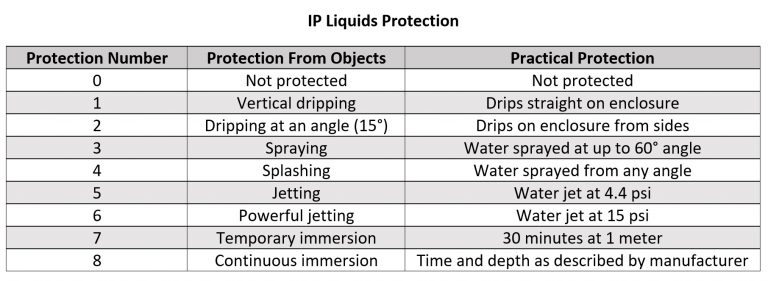
Data ouput
An SPC output lets you send measurements to a printer or computer. Most won’t need this feature, but it could come in handy in a high volume machine shop.
Related articles
For more information check out these related articles:
